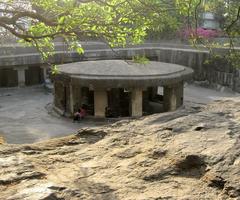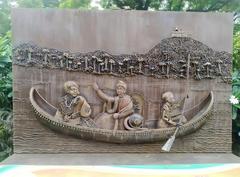Raj Bhavan Pune: Visiting Hours, Tickets, and Historical Significance Guide
Date: 04/07/2025
Introduction
Raj Bhavan Pune, nestled in the Ganeshkhind area, is a magnificent testament to Maharashtra’s layered colonial and post-independence legacy. Originally established as the Government House in 1866, this estate has evolved from a monsoon retreat for British governors to the official residence of the Governor of Maharashtra. Today, Raj Bhavan stands as a symbol of governance, architectural splendor, and a living chronicle of Pune’s political and cultural history. This comprehensive guide details everything visitors need to know—including historical background, visiting hours, ticketing, accessibility, travel tips, and nearby attractions—to ensure a memorable and enriching experience (Maharashtra Raj Bhavan Official Site, The Hindu, GRIHA India).
Table of Contents
- Early Origins and Colonial Foundations
- Role During the British Raj
- Transition to Indian Administration
- Architectural Highlights and Heritage Value
- Historical Events and Notable Visitors
- Visiting Raj Bhavan Pune: Hours, Tickets, and Visitor Information
- Facilities, Accessibility, and Travel Tips
- Nearby Attractions
- Frequently Asked Questions (FAQs)
- Conclusion and Visitor Recommendations
- References
Early Origins and Colonial Foundations
Raj Bhavan’s roots trace back to the British Raj, when Pune was strategically selected as the monsoon capital of the Bombay Presidency. In 1866, the Government House was established atop Ganeshkhind’s gentle hills, combining grandeur with seclusion. Its construction symbolized the administrative authority of the British in western India, with its design blending Victorian Gothic and Indo-Saracenic architectural motifs—expansive verandas, high ceilings, ornate cornices, and lush gardens (Maharashtra Raj Bhavan Official Site, The Hindu).
Role During the British Raj
Throughout the late 19th and early 20th centuries, Raj Bhavan Pune served as the Governor’s monsoon residence, where crucial political and administrative decisions were made. The estate hosted British officials, Indian royalty, and dignitaries, fostering both governance and high society gatherings. Its proximity to key institutions, such as the University of Pune (established on adjacent land in 1949), underlined its influence in the city’s development (Indian Express, Savitribai Phule Pune University).
Transition to Indian Administration
Following India’s independence in 1947, Raj Bhavan was seamlessly integrated into the new Indian administrative framework, becoming the Pune residence of the Governor of Maharashtra. The estate retained its ceremonial and political significance, while undergoing careful preservation and adaptation to serve the needs of a modern state. Heritage artifacts, portraits, and colonial-era furnishings were maintained, and periodic renovations were carried out to balance tradition with contemporary requirements (Times of India).
Architectural Highlights and Heritage Value
Raj Bhavan’s architecture is a harmonious blend of British colonial and Indian influences. The estate encompasses approximately 411 acres, including manicured lawns, botanical gardens, and wooded areas teeming with native flora and migratory birds. Key structures include:
- Punya Bhushan: The main residence and office of the Governor, originally a guest house built in 1888 (GRIHA India).
- VIP Guest House: Modern accommodations for high-profile state guests.
- Heritage Interiors: Featuring British-era chandeliers, Sinhalese Bell, cast-iron cannon, and period furnishings (cdnbbsr.s3waas.gov.in).
The estate’s landscape design, inspired by English traditions, offers tranquil walking paths and a sanctuary for biodiversity, earning Raj Bhavan a GRIHA 5-Star rating for sustainability (GRIHA India).
Historical Events and Notable Visitors
Raj Bhavan Pune has hosted a remarkable array of dignitaries, from British viceroys to Indian presidents and international guests. Noteworthy events include the visit of Queen Elizabeth II and Prince Philip in 1961, as well as pivotal political meetings and cultural ceremonies (British Royal Visits to India). The estate is also linked to important episodes in Pune’s freedom movement, such as the assassination of British official Walter Charles Rand by the Chaphekar brothers—an event highlighted in guided tours (Wikipedia: Raj Bhavan, Pune).
Visiting Raj Bhavan Pune: Hours, Tickets, and Visitor Information
Visiting Hours
- Open: Tuesday to Sunday, 10:00 AM to 5:00 PM
- Closed: Mondays, public holidays, and the monsoon season (22nd June to 30th September)
Ticketing and Booking
- Entry: Free of charge, but advance online booking is mandatory (Raj Bhavan Pune Ticket Booking).
- Registration: Each visitor must register individually with valid government-issued photo ID.
- Group Visits: Permitted, but require separate registrations for each member.
- Special Appointments: For official or educational visits, contact via email at [email protected].
Guided Tours
- Duration: 60–90 minutes, available in English and Marathi.
- Highlights: Sunrise Gallery, landscaped gardens, heritage interiors, Governor’s residence (“Punya Bhushan”), VVIP guest houses, and Devi Mandir (subject to security clearance).
- Photography: Permitted only in designated outdoor areas.
Seasonal Considerations
- Best Time to Visit: October–February, when gardens are in full bloom and the weather is pleasant.
- Closure: Estate is closed for maintenance and safety during the monsoon.
Facilities, Accessibility, and Travel Tips
- Location: Ganeshkhind, near Savitribai Phule Pune University.
- Transport: Accessible via public buses, taxis, or private vehicles; parking available for pre-registered visitors.
- Accessibility: Wheelchair-friendly ramps and pathways; restrooms and drinking water stations on site.
- Visitor Conduct: Modest attire is required; smoking, alcohol, food, and picnicking are prohibited; children must be supervised.
- Security: Visitors undergo bag checks and ID verification; certain items (large bags, sharp objects) are restricted.
- Travel Tips:
- Arrive early for security screening.
- Wear comfortable shoes; the grounds are extensive.
- Carry reusable water bottles.
- Plan extra time to explore nearby attractions.
Nearby Attractions
Enhance your Raj Bhavan visit by exploring these nearby Pune historical sites:
- Shaniwar Wada: Iconic 18th-century fort and palace complex.
- Aga Khan Palace: Monument associated with Mahatma Gandhi and the freedom movement.
- Savitribai Phule Pune University: Renowned educational campus adjacent to Raj Bhavan.
- Pataleshwar Cave Temple: Ancient rock-cut shrine.
- Sarasbaug Ganesh Temple: Popular temple with picturesque gardens.
Frequently Asked Questions (FAQs)
Q1: What are Raj Bhavan Pune’s visiting hours?
A1: Tuesday to Sunday, 10:00 AM to 5:00 PM, except Mondays, public holidays, and the monsoon season.
Q2: How can I book tickets to Raj Bhavan Pune?
A2: Tickets are free but require advance online booking via the official Raj Bhavan website.
Q3: Is photography allowed inside Raj Bhavan?
A3: Photography is permitted in designated outdoor areas; indoor photography is generally restricted.
Q4: Are guided tours available?
A4: Yes, guided tours in English and Marathi are offered and recommended.
Q5: Is Raj Bhavan accessible for differently-abled visitors?
A5: Yes, the estate provides ramps and accessible pathways.
Conclusion and Visitor Recommendations
Raj Bhavan Pune is far more than a historic government residence—it is a living symbol of Pune’s political, architectural, and ecological evolution. Its blend of Victorian Gothic and Indo-Saracenic architecture, meticulously maintained gardens, and rich archives create a unique window into India’s colonial past and democratic present. Public access, now possible through guided tours, allows visitors to experience the estate’s grandeur and legacy firsthand.
Visitor Tips:
- Plan your visit during October–February for the best experience.
- Book online well in advance due to security and limited slots.
- Explore nearby historical sites to enrich your understanding of Pune’s heritage.
- Check the official website for updates on closures and special events.
- Download the Audiala app for travel planning and curated heritage insights.
References
- Maharashtra Raj Bhavan Official Site
- The Hindu
- Indian Express
- Savitribai Phule Pune University
- Times of India
- British Royal Visits to India
- GRIHA India
- cdnbbsr.s3waas.gov.in
- Wikipedia: Raj Bhavan, Pune
Image Alt Text Suggestions:
- “Front view of Raj Bhavan Pune showcasing colonial architecture”
- “Lush landscaped gardens of Raj Bhavan Pune with mature trees”
- “Interior of Punya Bhushan residence featuring period chandeliers”
- “Cast-iron cannon displayed outside Raj Bhavan Pune”
Note: Embed images and virtual tour links as per publication platform capabilities.




